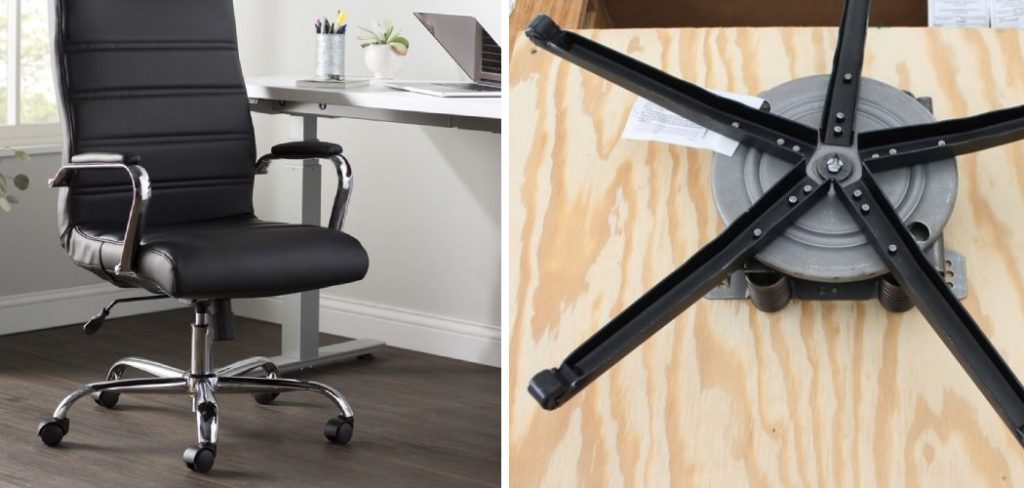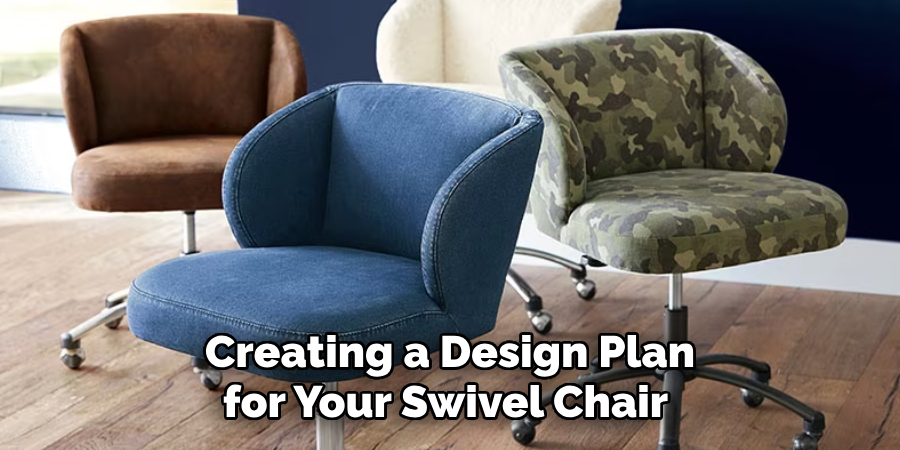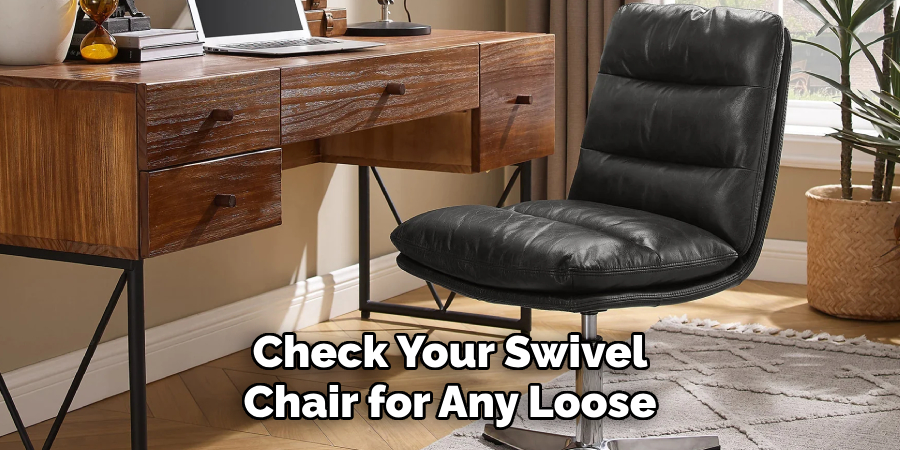A swivel chair allows you to rotate in different directions while remaining seated. It’s an essential piece of furniture for many homes and offices, providing comfort and functionality.

Whether looking for a stylish addition to your living room or a practical addition to your workspace, making your swivel chair can be a fun and rewarding project. This guide discusses the materials and steps you need on how to make a swivel chair and customize it to suit your needs. If you’re ready to start, let’s dive into the DIY furniture-making world!
Understanding Swivel Chair Design
Before embarking on making a swivel chair, it’s essential to understand its design. A typical swivel chair consists of four main parts: the base, seat, backrest, and armrest. The base provides stability and support and is usually made of metal or wood.
The seat and backrest are the main components that provide comfort while sitting. They can be made of various materials, including fabric, leather, or wood. The armrests offer additional support and are usually attached to the backrest or seat.
There are two main types of swivel mechanisms: ball-bearing swivel and gas lift swivel. A ball-bearing swivel uses small metal balls to allow smooth rotation, while a gas lift swivel employs pressurized gas to adjust the chair’s height. Understanding these design elements will help you choose the right materials and build a sturdy and functional swivel chair.
Tools and Materials You Will Need to Make a Swivel Chair
- Wood or metal for the base and frame
- Upholstery foam for cushioning
- Fabric or leather for covering the seat and backrest
- Screws, nails, and other fasteners
- Drill and drill bits
- Saw or jigsaw
- Sandpaper and wood glue
- Sewing machine (if using fabric)
- Pliers and screwdrivers
Step-by-step Guidelines on How to Make a Swivel Chair
Step 1: Design and Planning

Before starting the construction process, creating a design plan for your swivel chair is essential. Consider the size, style, and materials you want to use. You can sketch out your design or use online furniture design tools for more accurate measurements. This step will also help you estimate the materials and tools needed. If you’re new to DIY projects, starting with a simple design is best.
Step 2: Building the Base and Frame
The base is the foundation of your swivel chair, so it needs to be sturdy. If using wood, cut four pieces for the legs and two for the seat frame. You can use pre-made metal bases or weld them together to form a square or circle shape. Next, attach the legs to the seat frame using screws or wood glue. Reinforce with additional support if necessary. Ensure the base is level and can support the chair’s weight.
Step 3: Creating the Seat and Backrest
Cut out your desired shape for the seat and backrest from sturdy plywood. You can also use a cushioned foam for added comfort. Attach them to the frame using wood glue, ensuring they are secure. If you plan to add armrests, attach them to the backrest using screws or wood glue. If using fabric or leather, cover the seat and backrest with them and secure them with a staple gun.
Step 4: Installing the Swivel Mechanism
Refer to your chosen swivel mechanism’s instructions and follow them carefully. Generally, you will need to attach it to the chair’s underside and connect it to the base using screws. Test the rotation before proceeding. If using a gas lift swivel, attach it to the seat frame for adjustable height. If using a ball-bearing swivel, ensure it is lubricated for smooth rotation.
Step 5: Finishing Touches

Inspect your swivel chair for any rough edges or loose parts. Sand them down and tighten any screws or fasteners if needed. You can also add a coat of paint or varnish to enhance the appearance and protect the wood. Place your swivel chair in its designated spot, and enjoy your creation. Make sure to test its rotation and adjust the height (if applicable) for comfortable use.
Following these steps and using quality materials will result in a functional and stylish swivel chair you can proudly say you made yourself. With this guide, you can now customize your own swivel chair to fit your specific needs and preferences. So why not add a unique piece of furniture to your home or workspace? Happy DIY-ing!
Additional Tips and Tricks to Make a Swivel Chair:
- If you want to add a little extra cushioning to your swivel chair, consider getting a seat pad or lumbar support pillow. This can make sitting for long periods of time more comfortable and reduce strain on your back.
- Adjust the height and tilt of your chair regularly throughout the day. This will help promote good posture and prevent discomfort.
- If you work in an office setting, consider investing in a standing desk or alternating between sitting and standing throughout the day. This can help reduce the negative effects of prolonged sitting.
- When using a swivel chair, sit flat on the ground and keep your knees at a 90-degree angle. Avoid crossing your legs or tucking them under the chair, as this can pressure your lower back and legs.
- Take breaks throughout the day to stretch and move around. This will help prevent stiffness and promote blood circulation.
- Consider using an ergonomic mouse or keyboard to reduce strain on your hands, wrists, and arms while working in a swivel chair.
- Adjust the height of your computer monitor to eye level. This will help prevent neck strain and promote good posture.
- Ensure that your swivel chair has proper lumbar support to maintain the natural curve of your spine.
- Avoid slouching or leaning too far back in your swivel chair, as this can put pressure on your lower back and cause discomfort.
- Finally, consider taking a few moments each day to do simple stretches or exercises specifically targeting the muscles used while sitting in a swivel chair. This can help prevent any long-term negative effects on your body.

Following these additional tips and tricks can greatly improve your swivel chair experience. Remember to always prioritize good posture and take breaks throughout the day to prevent discomfort and promote overall well-being. Happy sitting!
Things You Should Consider to Make a Swivel Chair
1. The base is the first thing you must consider when making a swivel chair. This part of the chair attaches to the seat, allowing it to rotate 360 degrees. This base must be stable and durable, as it will support the weight of anyone sitting on the chair. It should also have a smooth rotation mechanism, making it effortless to move.
2. Seating is another important factor when creating a swivel chair. It should be comfortable and supportive, as people will spend extended periods sitting on it. Consider using high-quality foam or padding for added comfort. Additionally, the size and shape of the seat must be suitable for various body types.
3. The backrest is another crucial element to consider. It should provide ample support for the lower back and promote good posture. A well-designed backrest reduces strain on the spine, preventing discomfort and potential injuries. Adjustable options are even better as they allow users to customize the chair to their liking.
4. Armrests are often overlooked when making a swivel chair but can greatly enhance comfort. They should be at a height that allows the user’s arms to rest comfortably while typing or doing other tasks. The armrests should also have padding for added support and prevent shoulder strain.
5. The material used for the chair must also be carefully considered. It should be comfortable and durable, as it will experience a lot of wear and tear. Materials such as leather, mesh, and fabric are common choices for swivel chairs, each with its advantages. For example, leather offers a luxurious feel, while mesh is breathable and suitable for warmer climates.
6. Adjustability is another essential factor when creating a swivel chair. The seat height, backrest angle, and armrest position should all be adjustable to accommodate different body types and preferences. This feature ensures that the chair can be used comfortably by multiple people.
7. Lastly, consider adding additional features such as lumbar support or a headrest for added comfort. These features can significantly affect the swivel chair’s overall comfort and ergonomics.

Following these considerations will help you create a comfortable and functional swivel chair that promotes good posture and prevents discomfort. Before finalizing it, remember to test the chair to ensure it meets your ergonomic needs. With the right design and materials, your custom-made swivel chair can provide comfort and support for years to come. Happy chair-making!
Maintenance Tips for a Swivel Chair
1. Regular Cleaning:
One of the most important maintenance tips for a swivel chair is to clean it regularly. This will not only keep your chair looking good, but it will also help prolong its lifespan. Dirt and dust can easily accumulate on the surface and in the crevices of your chair, causing wear and tear over time.
To clean your swivel chair, dust the surface with a soft cloth or vacuum cleaner. Next, use mild soap and warm water to wipe down the entire chair, including the base and wheels. For any stubborn stains or spills, you can use a gentle cleaner specifically designed for upholstery.
It’s important to note that you should avoid using harsh chemicals or abrasive cleaners, as they can damage the fabric or material of your chair. After cleaning, make sure to dry the chair thoroughly with a clean towel.
2. Lubrication:
Another important maintenance tip for a swivel chair is lubricating its moving parts regularly. Over time, the wheels and mechanisms of your chair can become stiff or squeaky due to friction and lack of lubrication. To avoid this, use a silicone-based spray or oil to lubricate your swivel chair’s wheels, bearings, and other moving parts. This will help your chair move smoothly and prevent any potential damage.
3. Check for Loose Parts:

Periodically check your swivel chair for any loose or broken parts. This includes the wheels, armrests, and backrests. If you notice any loose parts, tighten them immediately to prevent any further damage or potential accidents. It is also important to check the screws and bolts that hold your chair together and tighten them if needed.
4. Proper Use:
Using your swivel chair properly can also help prolong its lifespan. Avoid sitting on the armrests, leaning too far, or placing heavy objects on the chair. These actions can put unnecessary stress on the chair’s structure and lead to damage over time. Also, make sure to adjust your chair according to your body size and posture for maximum comfort and support. This will help prevent strain on your body and the chair itself.
5. Storage:
If you plan on storing your swivel chair for a long period of time, make sure to do it properly. Store the chair in a dry and cool place to avoid any potential damage from humidity or extreme temperature changes. Cover the chair with a cloth or plastic sheet to protect it from dust and debris. Avoid storing the chair in direct sunlight, as it can cause fading or discoloration of the fabric or material.
Following these maintenance tips will keep your swivel chair in good condition and ensure you can use it for years. Remember to clean, lubricate, check for loose parts, use the chair properly, and store it correctly. With proper maintenance, your swivel chair will remain a comfortable and functional piece of furniture in your home or office space. So, remember these tips and enjoy your swivel chair for many more years. Happy sitting!
Precautions Need to Be Followed for Making a Swivel Chair
- Ensure you have enough space in your room or office to accommodate a swivel chair. Swivel chairs are usually larger than regular chairs and need more area.
- Secondly, ensure that the surface where the swivel chair will be placed is flat and even. The base of the swivel chair should be able to rest evenly on the ground without any wobbling.
- Check the swivel chair’s weight capacity and ensure you do not exceed it. Overloading a chair can result in breakage or damage to the chair, leading to accidents.
- Before sitting on a swivel chair, inspect all parts for any wear and tear or loose screws. If you find any issues, get them fixed before using the chair.
- When sitting in a swivel chair, ensure your feet are firmly planted on the ground. This will provide stability and prevent accidental tipping or falling off the chair.
- Avoid leaning too far back in a swivel chair as it can cause loss of balance and result in accidents.
- Do not excessively spin on a swivel chair, especially when sitting at a desk or table. This can strain your neck and back muscles and cause discomfort.
- If the swivel chair has armrests, adjust them correctly to support your arms while working.
- Keep the area around the swivel chair free from any obstacles, such as cords or clutter, that may get caught in the rotating mechanism.

Following these precautions will ensure your safety and the longevity of your swivel chair. Remember to clean and maintain your swivel chair regularly to keep it in good condition. Happy sitting!
Frequently Asked Questions
What is a Swivel Chair?
A swivel chair is a type of seating furniture with a central rotation point, allowing the user to rotate or turn the seat in any direction. It typically has a single, sturdy base with casters or wheels for mobility. Swivel chairs are commonly used in offices, home offices, and even living rooms as they provide versatility and ease of movement.
Can I Make My Own Swivel Chair?
Yes, you can make your own swivel chair. There are various DIY tutorials and guides available online that provide step-by-step instructions on how to create a custom swivel chair using basic materials such as wood, screws, and a swivel mechanism. Making your swivel chair gives you a unique and personalized piece of furniture that meets your needs and preferences.
What If I Need the Skills or Tools to Make a Swivel Chair?
If you don’t have the skills or tools to make a swivel chair, you can purchase a pre-made one from furniture stores. Many furniture stores offer a variety of swivel chairs in different styles and designs, giving you plenty of options to choose from. Consider hiring a professional carpenter or furniture maker to create a custom swivel chair for you. They have the expertise and tools to bring your vision to life.
Are Swivel Chairs Comfortable?

Swivel chairs are designed for comfort and functionality. Rotating or turning the seat makes reaching different workspace areas easier without straining your body. Additionally, swivel chairs often come with adjustable features such as height, tilt, and armrests, allowing you to customize them to your body and preferences for maximum comfort.
Conclusion
Now you know how to make a swivel chair and its benefits. Whether you choose to make your own or purchase one, a swivel chair can be a practical and stylish addition to any workspace or living room.
Remember to consider factors such as material, design, and functionality when choosing a swivel chair that suits your needs. With the right choice, you can enjoy the comfort and convenience of a swivel chair for years to come. So, why not try it and make your own swivel chair or invest in one today? Happy swiveling!
Huston Douthit is a distinguished figure in the world of furniture design, with a decade of expertise creating innovative and sustainable furniture solutions. His professional focus lies in merging traditional craftsmanship with modern manufacturing techniques, fostering designs that are both practical and environmentally conscious. As the author of Fruniturix, Huston delves into the art and science of furniture-making, inspiring artisans and industry professionals alike.
Education
- RMIT University (Melbourne, Australia)
Associate Degree in Design (Furniture)- Focus on sustainable design, industry-driven projects, and practical craftsmanship.
- Gained hands-on experience with traditional and digital manufacturing tools, such as CAD and CNC software.
- Nottingham Trent University (United Kingdom)
Bachelor’s in Furniture and Product Design (Honors)- Specialized in product design with a focus on blending creativity with production techniques.
- Participated in industry projects, working with companies like John Lewis and Vitsoe to gain real-world insights.
Publications and Impact
In Fruniturix, Huston shares his insights on furniture design processes, materials, and strategies for efficient production. His writing bridges the gap between artisan knowledge and modern industry needs, making it a must-read for both budding designers and seasoned professionals.


